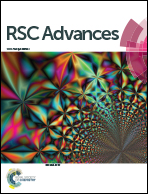Energetics and optical properties of carbon impurities in rutile TiO2†
Abstract
Titanium dioxide is one of the most promising materials for many applications such as photovoltaics and photocatalysis. Non-metal doping of TiO2 is widely used to improve the photoconversion efficiency by shifting the absorption edge from the UV to visible-light region. Here, we employ hybrid density-functional calculations to investigate the energetics and optical properties of carbon (C) impurities in rutile TiO2. The predominant configurations of the C impurities are identified through the calculated formation energies under O-poor and O-rich growth conditions. Under the O-poor condition, we find that C occupying the oxygen site (CO) is energetically favorable for Fermi-level values near the conduction band minimum (n-type TiO2), and acts as a double acceptor. Under the O-rich condition, the Ci–VTi complex is energetically favorable, and is exclusively stable in the neutral charge state. We also find that interstitial hydrogen (Hi) can bind to CO, forming a CO–Hi complex. Our results suggest that CO and CO–Hi are a cause of visible-light absorption under oxygen deficient growth conditions.



 Please wait while we load your content...
Please wait while we load your content...